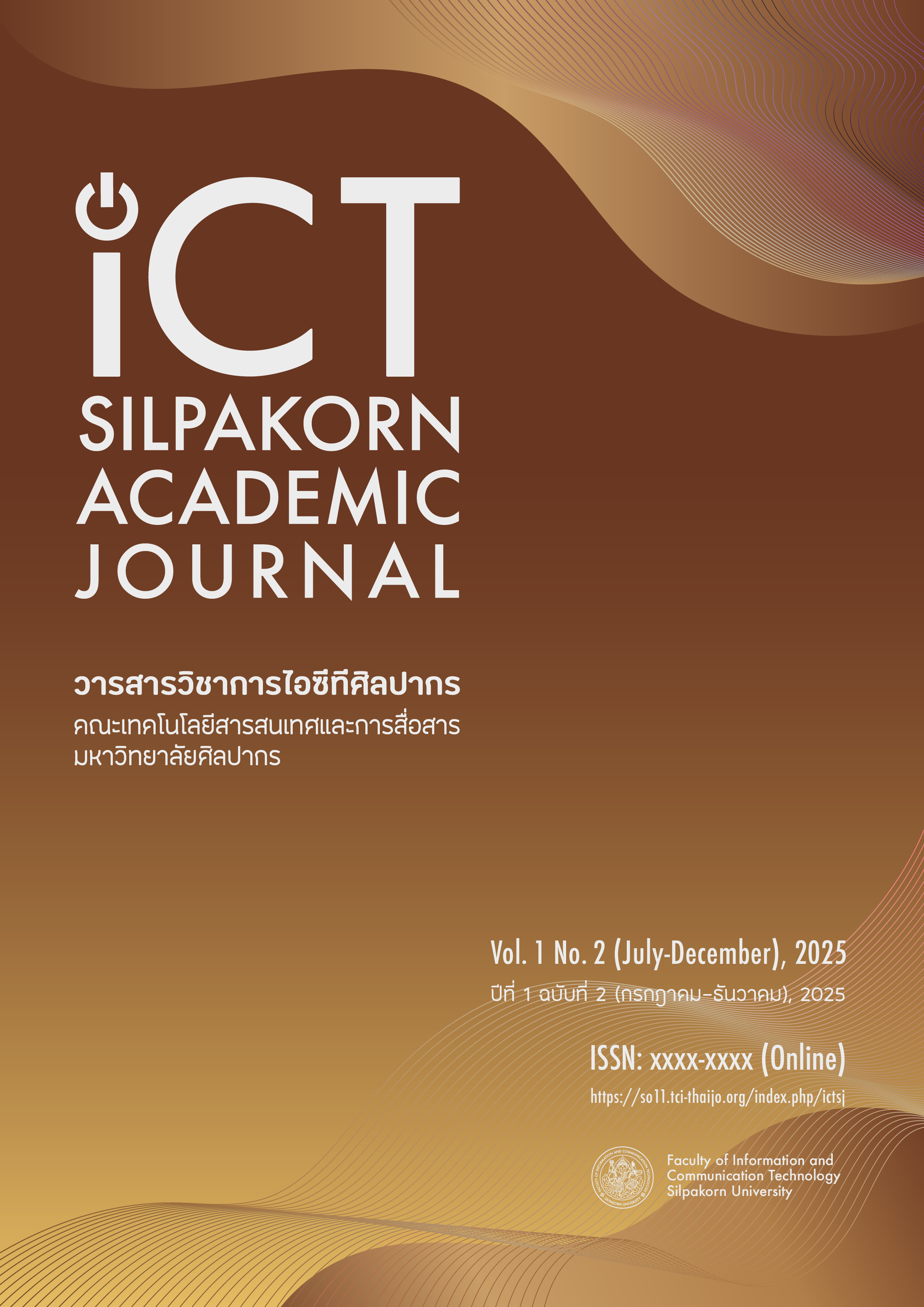Film-Induced Tourism กับการท่องเที่ยวไทย: บทวิเคราะห์แนวคิด พัฒนาการ และกรณีศึกษา
Main Article Content
บทคัดย่อ
Article Details

อนุญาตภายใต้เงื่อนไข Creative Commons Attribution-NonCommercial-NoDerivatives 4.0 International License.
Copyright © 2025 ICT Silpakorn All rights reserved.
เอกสารอ้างอิง
AFI (American Film Institute). (2024). AFI catalog of feature films: The first 100 years 1893–1993. The Bridge on the River Kwai. https://catalog.afi.com/Catalog/moviedetails/52118
AFP. (2011, June 23). Hangover II: No headache for Thailand. The Independent. https://www.independent.co.uk/travel/news-and-advice/hangover-ii-no-headache-thailand-2303114.html
Ágnes, U. T. (2018). Movie-induced tourism and its effects on settlements. SEC, 2(3). ARM Academic Publishing.
Alvarado-Sizzo, I., Sánchez-Aguirre, D. P., & Aldaz Galicia, N. Y. (2024). From film tourism to media pilgrimage: Visiting the ‘real Mama-Coco’ in Indigenous Mexico. Economía, Sociedad y Territorio, 24(74), e2134. https://doi.org/10.22136/est20242134
Araújo-Vila, N., Foronda-Rodríguez, J. L., & Seabra, C. (2024). Film-induced tourism as a key factor for promoting tourist destinations: The James Bond saga. Administrative Sciences, 14(5), 94. https://doi.org/10.3390/admsci14050094
Atlantic Council. (2025). Surfing the Hallyu: What Taiwan can learn from South Korea’s cultural diplomacy. https://www.atlanticcouncil.org/in-depth-research-reports/issue-brief/surfing-the-hallyu-what-taiwan-can-learn-from-south-koreas-cultural-diplomacy/
Beeton, S. (2005). Film-induced tourism. Channel View Publications.
Beeton, S. (2015). Travel, tourism and the moving image. Channel View Publications.
Beeton, S., Yamamura, T., & Seaton, P. (2013). The mediatisation of culture: Japanese contents tourism and pop culture.Routledge. https://doi.org/10.4324/9781315594613
Birdsall, H. (2022). Disney’s media parks: The convergence of theme parks, film, television, and game space (Master’s thesis). University of California, LosAngeles. https://escholarship.org/uc/item/ 4z88c0k7
Bolan, P. (2010). Film-induced tourism: Motivation, authenticity and displacement (Doctoral dissertation). University of Ulster.
Braithwaite, R. W., & Leiper, N. (2010). Contests on the River Kwai: How a wartime tragedy became a recreational, commercial and nationalistic plaything. Current Issues in Tourism, 13(4), 311–332. https://doi.org/10.1080/13683500903250745
CEA (Creative Economy Agency, Public Organization). (2024). Content lab: Strengthening Thailand’s creative ecosystem.
China Daily. (2014, September 30). People’s Daily Online: A visit to the shooting place of Go Lala Go!. http://www.chinadaily.com.cn/culture/2014-09/30/content_18682446.htm
CNN. (2011, May 27). The Hangover Part II: Follow the Wolf Pack’s Thailand trail. http://edition.cnn.com/2011/TRAVEL/05/27/hangover.2.thailand.travels.cnngo/index.html
Couldry, N. (2007). Pilgrimage in mediaspace: Continuities and transformations. Etnofoor, 20(1), 63–74.
Forsyth, T. (2001). What happened on The Beach? Social movements and governance of tourism in Thailand. International Journal of Sustainable Development, 5(3), 326–337. https://doi.org/10.1504/IJSD.2001.001548
Gjorgjievski, M., & Trpkova, S. M. (2012). Movie-induced tourism: A new tourism phenomenon. UTM Journal of Economics, 3(1), 97–104.
Gunesch, K. (2017). Film and tourism: Attracting travelers with moving images [Conference presentation]. RSEP International Conferences on Social Issues and Economic Studies, Prague, Czech Republic.
Husa, L. C. (2023). Dark tourism in Thailand: The “touristification” of wartime atrocities and crime. Austriaca.
Huttasin, N. (2016). Competitive advantage in film-induced tourism in Thailand: The case of Alexander the Great. Asian Journal of Tourism Research, 1(Special Issue, September), 88–113.
Jung, C.-W. (2007). A study on sustainability of Korea film-induced tourism: An empirical identification of life cycle of Korean wave film’s effects on foreign tourist attraction through tourism area (Master’s thesis). School of Public Policy and Management, Korea.
Jones, B. (2024). Screen tourism. Screen Industries Growth Network (SIGN).
Kachin, P. (2022). Discourse on tourism in Thai travel magazines. (Master’s thesis). Prince of Songkla University.
Kamon, B. (2022). The Hallyu policies of the Korean government. Journal of Language and Culture, 41(2), July–December.
Khoo-Lattimore, C., & Mura, P. (Eds.). (2017). Perspective on Asian tourism. Springer. https://doi.org/10.1007/978-981-10-8709-0
Kim, S. (2010). Extraordinary experience: Re-enacting and photographing at screen tourism locations. Tourism and Hospitality Planning & Development, 7(1), 5975. https://doi.org/10.1080/14790530903522630
Kim, S., & Reijnders, S. (Eds.). (2018). Film tourism in Asia: Evolution, transformation and trajectory. Springer. https://doi.org/10.1007/978-981-10-7653-7
King, V. T. (2018). Tourism and leisure in Thailand: Erik Cohen and beyond (Institute of Asian Studies Working Paper Series No. 40). Universiti Brunei Darussalam.
Klemm, A. J. (2016, July 1–2). Foreign film production in Thailand: Past, present and future [Conference presentation]. Bangkok University Communication Arts Conference, Bangkok University Rangsit Campus, Bangkok, Thailand.
Klemm, A. J. (2019). Thailand as a foreign film production destination: Developments and challenges from 2016 to 2018. Southeast Asian Media Studies Journal, 1(2), 32–45. https://doi.org/10.6118/seamsj.2019.1.2.32
Law, L., Bunnell, T., & Ong, C. (2007). The Beach, the gaze and film tourism. Tourist Studies, 7(2), 141–164. https://doi.org/10.1177/1468797607076675
Lebua.com. (2019). Lebua at State Tower. https://lebua.com/hotels/lebua-at-state-tower/
Li, D., & Luo, S. (2017). The selfie of the other: The Chinese dream in films and tourism. Asian Cinema, 28(1), 1–18. https://doi.org/10.1386/ac.28.1.1_1
Marsh, L. L., & Li, H. (Eds.). (2016). The middle class in emerging societies: Consumers, lifestyles and markets.Routledge. https://doi.org/10.4324/9781315732329
Mostafanezhad, M., & Promburom, P. (2016). Lost in Thailand: The popular geopolitics of film-induced tourism in Northern Thailand. Social & Cultural Geography, 18(5), 1–21. https://doi.org/10.1080/14649365.2016.1257735
Muangin. A (2015). The King and I: A scandalous film for Siam (ภาพยนตร์ที่แสนอื้อฉาวสำหรับสยามประเทศ). Blogazine. https://blogazine.pub/blogs/atthasit-muangin/post/5508
NPR.org. (2013, February 7). Move over James Bond, China has an unlikely box-office champ. National Public Radio, Inc. https://www.npr.org/2013/02/07/171399652/move-over-james-bond-china-has-an-unlikely-box-office-champ
Paprach, T., & Hashim, R. (2022). Destination space in film: Viewer perspectives on film destination contributions to promoting Thai tourism. Tourism, Culture & Communication, 23(1), 61–79. https://doi.org/10.3727/109830422X16571163012924
Phomsiri, S. (2015). Film tourism and destination marketing: Case studies of in-bound and out-bound in Thailand. Integrative Business & Economic Research, 4(3), 95–107.
Rasameeviangchai, A. (2019). Thailand in foreign films. Journal of Communication and Media, 10 (1), 151–172. https://so06.tcithaijo.org/index.php/jcmag/article/view/220184
Reijnders, S. (2010). On the trail of 007: Media pilgrimages into the world of James Bond. Area, 42(3), 369–377. https://doi.org/10.1111/j.1475-4762.2010.00928.x
Reijnders, S., Martens, E., Nanjangud, A., Castro, D., Schiavone, R., & Póvoa, D. (2024). Media, place and tourism: Worlds of imagination. Routledge. https://doi.org/10.4324/9781003374405
Rewtrakunphaiboon, W. (2009). Film-induced tourism: Inventing a vacation to a location. BU Academic Review, 8(1), 33–42.
Riley, R., Baker, D., & Van Doren, C. S. (1998). Movie-induced tourism. Annals of Tourism Research, 25(4), 919–935. https://doi.org/10.1016/S0160-7383(98)00045-3
Rungchawannont, M. (2015). A journey to the past: An analysis of the contemporary display of the Death Railway, Thailand (Master’s thesis). Faculty of Archaeology, Leiden University.
Said, E. W. (1978). Orientalism. Pantheon Books. University of Michigan.
Seaton, P., & Yamamura, T. (2014). Japanese popular culture and contents tourism: Introduction. In Japanese popular culture and contents tourism (pp. 1–18). Routledge. https://doi.org/10.4324/9781315815275
Shang, H. (2015). Portrayal of Thailand: A comparative study of American and Chinese films (Master’s thesis). Bangkok University, Thailand.
Siripis, M. (2011). The role of film in mediating destination image and tourist practices: The Beach and Thailand (Doctoral dissertation). University of Surrey, United Kingdom.
Staszak, J.-F. (2021). Casablanca: Le film, la ville et les tourists. À propos du Rick’s Café et de quelques. Annales de Géographie, 130(741), 30–59. https://doi.org/10.3917/ag.741.0030
TAT Newsroom. (2025, January). Amazing Film Festival Experience and Be My Guest campaigns. Tourism Authority of Thailand. https://www.tatnews.org
Thacca.go.th. (2024). Annual report 2024. Thailand Creative Content Agency.
Thai Content Expo. (2025). The haunted houses of Thai horror: TCX 2025 program booklet. Thai Content Experience.
Thailand Film Office. (2025). Foreign production statistics. https://tfo.dot.go.th/foreign-production-statistic/
Tonsaithong, C. (2022). Marketing strategies for film-induced tourism. Silpakorn University e-Journal (Social Sciences, Humanities, and Arts), 42(2), (March-April) 45–60.
Tourism Authority of Thailand. (2025, January). Thailand ups the reel deal: New cash rebates for filmmakers now up to 30%. TAT Newsroom. https://www.tatnews.org/2025/01/thailand-ups-the-reel-deal-new-cash-rebates-for-filmmakers-now-up-to-30/
Turnbull, M. (2017). Interior set of Rick’s Café American on the set of ‘Casablanca’ (1942). https://martinturnbull.com/2017/11/10/interior-set-of-ricks-cafe-americain-on-the-set-of-casablanca-1942-2/
Tzanelli, R. (2004). Constructing the ‘cinematic tourist’: The sign industry of The Lord of the Rings. Tourist Studies, 4(1), 21–42. https://doi.org/10.1177/1468797604053077
Tzanelli, R. (2006). Reel western fantasies: Portrait of a tourist imagination in The Beach (2000). Mobilities, 1(1), 121–142. https://doi.org/10.1080/17450100500489152
Tzanelli, R. (2019). Cinematic tourist mobilities and the plight of development: On atmospheres, affects, and environments. Routledge.
Wasintapa, P., & Vungthong, S. (2019). A visual and linguistic analysis of Tourism Authority of Thailand’s posters. JHUMANS, 20(1), 41–80.
Yang, W. (2015). Lost in Thailand: Travel metaphors in contemporary Chinese comedy. East Asian Journal of Popular Culture, 1(3), 351–366. https://doi.org/10.1386/eapc.1.3.351_1
Zeng, Y., Xu, Z., Chen, L., & Huang, Y. (2023). Exploring the mechanism of empathy on lens language and linguistic landscape on movie-induced tourism: The moderating effect of cultural differences. Frontiers in Psychology, 14, 1109328. https://doi.org/10.3389/fpsyg.2023.1109328


